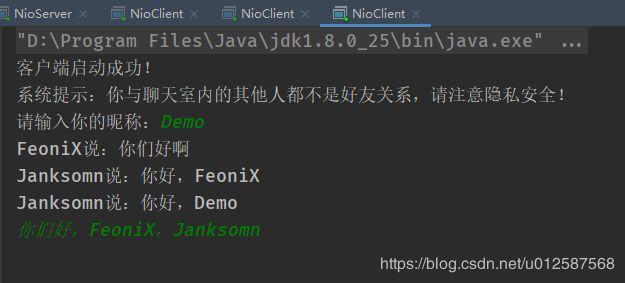我的Java学习之路(13)-- Java NIO网络编程制作简易聊天室
Java NIO网络编程制作简易聊天室
- 一、NIO简介
- 二、编程模型
- 三、BIO网络模型
- 四、NIO网络模型
- 五、具体代码实现
- 六、演示效果图
一、NIO简介
- NIO全称:Non-blocking IO 或 New IO,是非阻塞式的IO
- JDK版本:JDK1.4+
- 应用场景:高并发网络服务编程
二、编程模型
- 模型:对事物共性的抽象
- 编程模型:对编程共性的抽象
三、BIO网络模型
-
BIO网络模型介绍

从图中可以看出,一个线程到第5步的时候,会阻塞在那等待客户端的下次请求,每新增一个客户端,就会启动一个新的线程来处理这个客户端的请求,如果客户端量很大的话,就会造成服务器压力过大而崩溃。 -
BIO网络模型缺点
- 阻塞式IO模型
- 弹性伸缩能力差
- 多线程非常消耗资源
四、NIO网络模型
-
NIO网络模型介绍

相对于BIO,NIO的网络模型就要复杂的多,服务端提供一个单线程的Selector组件,它是一个事件注册监听器,负责监听管理注册到它上面的连接和事件,但是本身不负责处理客户端的业务逻辑。当它监听到指定的事件,就会启动相应的事件处理器去处理请求,事件处理器可以依次处理多个请求,处理完成之后,由事件处理器去响应客户端,Selector本身继续监听其他事件。 -
NIO模型的优点
- 非阻塞式IO模型
- 弹性伸缩能力强
- 单线程节约资源
- 原生NIO的缺点
- NIO类库和API比较复杂
- 可靠性能力补齐,工作量和难度都非常大
- Selector空轮询,导致CPU占用100%的bug还没有修复
五、具体代码实现
- 服务端代码
NioServer.java
package com.feonix;
import java.io.IOException;
import java.net.InetSocketAddress;
import java.nio.ByteBuffer;
import java.nio.channels.*;
import java.nio.charset.Charset;
import java.util.HashMap;
import java.util.Iterator;
import java.util.Map;
import java.util.Map.Entry;
import java.util.Set;
/**
* NIO服务器端
*/
public class NioServer {
/**
* 映射客户端channel
*/
private Map<String, SocketChannel> clientsMap = new HashMap<String, SocketChannel>();
public static void main(String[] args) {
NioServer nioServer = new NioServer();
try {
// 启动服务端
nioServer.start();
} catch (IOException e) {
e.printStackTrace();
}
}
/**
* 启动
*
* @throws IOException
*/
public void start() throws IOException {
// 1. 创建Selector
Selector selector = Selector.open();
// 2. 通过ServerSocket创建channel通道
ServerSocketChannel serverSocketChannel = ServerSocketChannel.open();
// 3. 为channel通道绑定监听端口
serverSocketChannel.bind(new InetSocketAddress(8000));
// 4. 将channel设置为非阻塞模式
serverSocketChannel.configureBlocking(false);
// 5. 将channel注册到selector上,监听连接事件
serverSocketChannel.register(selector, SelectionKey.OP_ACCEPT);
System.out.println("服务器端启动成功!");
// 6. 循环等待新接入的连接
for (; ; ) {
// 获取可用的channel数量
int readyChannels = selector.select();
// 屏蔽未就绪的连接,防止selector空轮询
if (readyChannels == 0) {
continue;
}
// 获取可用的channel集合
Set<SelectionKey> selectionKeys = selector.selectedKeys();
Iterator<SelectionKey> iterator = selectionKeys.iterator();
while (iterator.hasNext()) {
// 获取selectionKey实例
SelectionKey selectionKey = iterator.next();
// 移除当前的selectionKey
iterator.remove();
// 7. 根据就绪状态,调用对应的方法处理业务逻辑
// 接入事件处理逻辑
if (selectionKey.isAcceptable()) {
acceptHandler(serverSocketChannel, selector);
}
// 可读事件处理逻辑
if (selectionKey.isReadable()) {
readHandler(selectionKey, selector);
}
}
}
}
/**
* 接入事件处理器
*
* @param serverSocketChannel
* @param selector
*/
private void acceptHandler(ServerSocketChannel serverSocketChannel, Selector selector) throws IOException {
// 创建socketChannel
SocketChannel socketChannel = serverSocketChannel.accept();
// 将socketChannel设置为非阻塞模式
socketChannel.configureBlocking(false);
// 将channel注册到selector上,监听 可读事件
socketChannel.register(selector, SelectionKey.OP_READ);
// 回复客户端提示信息
socketChannel.write(Charset.forName("UTF-8").encode("系统提示:你与聊天室内的其他人都不是好友关系,请注意隐私安全!"));
}
/**
* 可读事件处理器
*
* @param selectionKey
* @param selector
* @throws IOException
*/
private void readHandler(SelectionKey selectionKey, Selector selector) throws IOException {
// 从selectionKey中获取到已经就绪的channel
SocketChannel socketChannel = (SocketChannel) selectionKey.channel();
// 创建buffer
ByteBuffer byteBuffer = ByteBuffer.allocate(1024);
// 循环读取客户端的请求信息
String request = "";
while (socketChannel.read(byteBuffer) > 0) {
// 切换buffer为读模式
byteBuffer.flip();
// 读取buffer中的内容
request += Charset.forName("UTF-8").decode(byteBuffer);
}
// 将channel再次注册到selector上,监听可读事件
socketChannel.register(selector, SelectionKey.OP_READ);
// 将客户端发送的信息广播给其他客户端
if (request.length() > 0) {
// 设置昵称的处理逻辑
if (request.contains("name:::")) {
String[] res = request.split(":::");
if (res.length == 2) {
// 添加昵称和客户端channel的映射
clientsMap.put(res[1], socketChannel);
System.out.printf("客户端%s加入聊天室\n", res[1]);
// 广播给其他客户端,有新用户加入聊天室
broadCast(socketChannel, res[1] + "加入聊天室,和Ta打个招呼吧~");
}
} else { // 普通消息的处理逻辑
// 先判断客户端channel映射map是否空
if (!clientsMap.isEmpty()) {
// 遍历客户端channel映射map
for (Entry<String, SocketChannel> clientSet : clientsMap.entrySet()) {
// 找到当前客户端channel
if (socketChannel.equals(clientSet.getValue())) {
// 拿到昵称
String name = clientSet.getKey();
System.out.printf("客户端%s消息:%s\n", name, request);
// 广播给其他客户端
broadCast(socketChannel, name + "说:" + request);
}
}
}
}
}
}
/**
* 广播消息
*/
private void broadCast(SocketChannel sourceChannel, String request) {
if (!clientsMap.isEmpty()) {
// 遍历所有已接入的客户端channel,循环向所有已接入客户端channel广播信息
clientsMap.entrySet().forEach(clientSet -> {
// 获取一个已接入的客户端channel
SocketChannel targetChannel = clientSet.getValue();
// 剔除发送消息的客户端
if (!sourceChannel.equals(targetChannel)) {
try {
// 将消息发送到targetChannel客户端
targetChannel.write(Charset.forName("UTF-8").encode(request));
} catch (IOException e) {
e.printStackTrace();
}
}
});
}
}
}
- 客户端代码
NioClient.java
package com.feonix;
import java.io.IOException;
import java.net.InetSocketAddress;
import java.nio.channels.SelectionKey;
import java.nio.channels.Selector;
import java.nio.channels.SocketChannel;
import java.nio.charset.Charset;
import java.util.Scanner;
/**
* NIO客户端
*/
public class NioClient {
public static void main(String[] args) {
NioClient nioClient = new NioClient();
try {
// 启动客户端
nioClient.start();
} catch (IOException e) {
e.printStackTrace();
}
}
/**
* 启动
*/
public void start() throws IOException {
// 连接服务器,指定ip和端口号
SocketChannel socketChannel = SocketChannel.open(new InetSocketAddress("127.0.0.1", 8000));
System.out.println("客户端启动成功!");
// 接收服务器端的响应
Selector selector = Selector.open();
// 设置非阻塞
socketChannel.configureBlocking(false);
// 向selector注册可读事件
socketChannel.register(selector, SelectionKey.OP_READ);
// 启动一个线程处理消息读取事件
new Thread(new NioClientHandler(selector)).start();
// 向服务器端发送消息
Scanner key = new Scanner(System.in);
System.out.print("请输入你的昵称:");
// 等待用户键盘输入昵称
String name = key.nextLine();
if (name != null && name.length() > 0) {
// 发送昵称给服务端
socketChannel.write(Charset.forName("UTF-8").encode("name:::" + name));
}
while (key.hasNextLine()) {
// 等待用户键盘输入消息内容
String request = key.nextLine();
if (request != null && request.length() > 0) {
// 发送消息给服务端
socketChannel.write(Charset.forName("UTF-8").encode(request));
}
}
}
}
- 客户端消息读取处理器
NioClientHandler.java
package com.feonix;
import java.io.IOException;
import java.nio.ByteBuffer;
import java.nio.channels.SelectionKey;
import java.nio.channels.Selector;
import java.nio.channels.SocketChannel;
import java.nio.charset.Charset;
import java.util.Iterator;
import java.util.Set;
/**
* 客户端消息读取处理器
*/
public class NioClientHandler implements Runnable {
private Selector selector;
public NioClientHandler(Selector selector) {
this.selector = selector;
}
@Override
public void run() {
try {
for (; ; ) {
// 获取可用的channel数量
int readyChannels = selector.select();
// 屏蔽未就绪的连接
if (readyChannels == 0) {
continue;
}
// 获取可用的channel集合
Set<SelectionKey> selectionKeys = selector.selectedKeys();
Iterator<SelectionKey> iterator = selectionKeys.iterator();
while (iterator.hasNext()) {
// 获取selectionKey实例
SelectionKey selectionKey = iterator.next();
// 移除当前的selectionKey
iterator.remove();
// 可读事件处理逻辑
if (selectionKey.isReadable()) {
readHandler(selectionKey, selector);
}
}
}
} catch (IOException e) {
e.printStackTrace();
}
}
/**
* 可读事件处理器
*/
private void readHandler(SelectionKey selectionKey, Selector selector) throws IOException {
// 从selectionKey中获取到已经就绪的channel
SocketChannel socketChannel = (SocketChannel) selectionKey.channel();
// 创建buffer
ByteBuffer byteBuffer = ByteBuffer.allocate(1024);
// 循环读取服务器端的响应信息
String response = "";
while (socketChannel.read(byteBuffer) > 0) {
// 切换buffer为读模式
byteBuffer.flip();
// 读取buffer中的内容
response += Charset.forName("UTF-8").decode(byteBuffer);
}
// 将channel再次注册到selector上,监听可读事件
socketChannel.register(selector, SelectionKey.OP_READ);
// 将服务器端响应的信息打印到本地
if (response.length() > 0) {
System.out.println(response);
}
}
}




